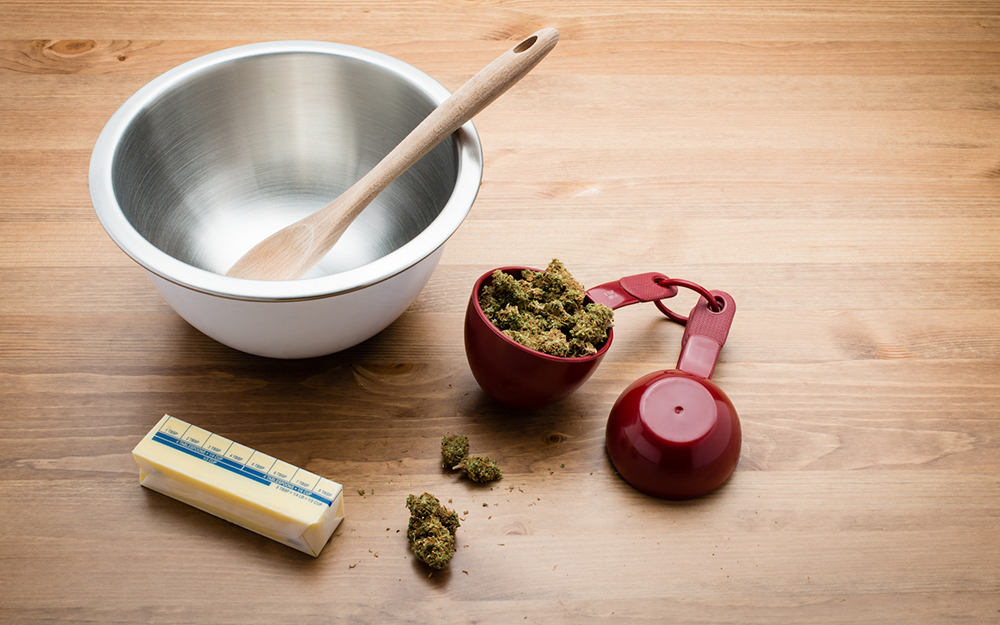
By LIBRA X HOTN
You’ve heard of edibles, but have you ever made your own? As Cannabis trends grow, so does infusing Cannabis and its’ oils into meals, treats and even drinks. The process to extract the beneficial flavors and components of the plant may seem overwhelming upon first glance, but let’s break down the basics for any Cannabis cooking beginner.
First Comes First
While eating raw leaves as a source of the natural anti-inflammatory THCA, is becoming popular on health scenes, most Cannabis recipes require you to extract or infuse the flower into the oil, butter, honey or base you’ll be cooking with. That’s why, the decarboxylation process comes first.
Decarboxylation or decarb, is a big word for ‘heating up’ (or baking) the bud to release the same components you would feel while ‘lighting up’ your weed in a bowl, bong, dab rig, etc. THCA and other compounds found in the trichomes of the plant must be heated to activate the THC allowing the effects to be felt. Choose a strain that you like the flavor, or effects of, to cater your cannabis culinary experience.
There is a variety of ways to decarb, but baking in your oven is the simplest form. You’ll spread your cannabis trim or nugs on a baking sheet and set oven to 220 degrees. Bake for 20-35 minutes depending on your oven settings. You’ll know your weed is decarbed when it’s gone from green to a toasted brown (but not too done!).
While some Cannabis cookers say to grind your bud before baking, beware as you may lose the kief, or ‘ice’ that contains the trichomes you’re activating with heat. Also, be aware that this process will be quite fragrant.
Infuse This
After your weed is decarbed, you can infuse it into practically any cooking oil, butter, syrup, honey, etc. The most commonly used would be butter or coconut oil, but there’s certainly no limit. The methods for infusing into your cooking substance may vary but here are a few of the most common for oils and butters – (1:1 cup ratio of material to oil).
Slow cooker on low for 4-6 hours, stir occasionally (or longer on warm – up to 24 hours).
Double-boiler on low for at least 6 hours, stir occasionally.
A simple saucepan on low for at least three hours, stir frequently (a saucepan is most susceptible to scorching).
In all cases, add a small amount of water to the mixture to help avoid burning. Once your oil/butter and bud are infused, strain through a cheesecloth into a jar or container and voila, you’re ready to cook with cannabis.
Dosage & Tips
Cooking with new flavors is fun… but remember your new canna-oil is packed with a punch! One tip to avoid overdoing your meal, or treats, is to reduce the amount of canna-oil/butter you’re using and use a regular version of the same oil to fill the necessary recipe amount (i.e if the recipe requires 1 cup of coconut oil, use ½ cup canna oil ½ regular coco oil).
Also, make sure you mix thoroughly so the infused oil incorporates evenly into your recipe.
To better identify dosages in your edibles, or meals, you’ll need an estimate of the THC amount in your weed. Some labels may identify this % on the packaging, or you can google the standard strain’s amount and use that as an estimate. The equation and example below is how to easily approximate dosage per treats or meals, but you can always use a dosage calculator found on many websites as well.
Below 10% THC is used as an example-
1 gram of weed = 1000 mg THC
10% THC x 1000 = 100 mg of THC in 1 gram used
# of grams in 1 cup oil/butter x 100 mg = ____ mg in 1 cup of oil/butter
(ex. 30 grams x 100 mg = 3000 mg in final oil/butter). Divide total mg per batch or serving.
Eat Your Weed
Cannabis food and drinks were just recognized as the hottest dining trend in 2019 by chefs, themselves. While marijuana is hitting the food scene, it’s just as easy to become a Cannabis chef at home! Save your shake, re-use trim, and start baking your way into a new high.










































